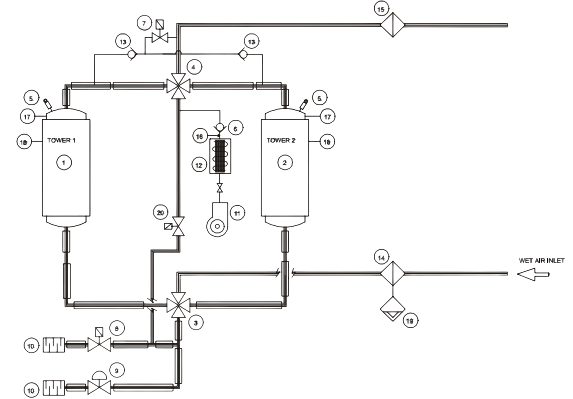Heated Desiccant
Air Dryer
A leading manufacturer since 1988
Heated Desiccant Air Dryer
Heatless adsorption dryer
Trident makes a range of adsorption dryers type compressed air dryers which are regenerated by heat. The adsorbents activated alumina or molecular sieve regenerates on heating. These type of Dryers are energy efficient for dew points below -20°C for large air flows. There are several ways to heat the bed of desiccant. The most common along with the Trident series are as follows:
Trident offers a variety of heat-regenerated Heatless adsorption dryers, including those using activated alumina or molecular sieve adsorbents. These dryers are highly energy efficient for achieving dew points below -20°C with large airflows. Trident’s dryers employ various heating methods for the desiccant bed. Here are some common approaches:

Blower heat reactivated dryer
(Series DB)
Trident Blower Heat Reactivated Air Dryers offers a very good dew point depending on the requirement. These dryers are useful for instrumentation air meeting the quality requirement of ISA S7.34. Available for any higher capacity from 500 cfm to 4000 cfm.
No-loss Split Flow Air Dryer
(Series DS)
Trident makes split flow dryers offers dewpoint of -40°c depending on the requirements. These dryers utilize heated part of air for regeneration and there is no air loss in this type of dryer. These dryers are available for any capacity higher than 500 scfm.
Heat of Compression Air Dryer
(Series DH)
These dryers use the hot air from compressor and utilize this energy to regenerate. They are very energy efficient
Principle of Operation
The Blower Heat Reactivated Dryer works on the principle of Thermal swing. The desiccant Adsorption dryers moisture from the compressed air to deliver dry air. The desiccant bed saturates over a period of time. The saturated bed is regenerated by heating with hot air generated using a blower. Hence, the dryer is called blower heat reactivated desiccant dryer. The temperature of the bed swings between the compressed air temperature and the regeneration temperature is called Thermal swing type. The hot air from the blower passed through a heater. This makes the air very dry. The hot air then heats up the desiccant bed. When the bed is heated, it gives up the moisture adsorbed and is ready for adsorption. The hot air carries this moisture to the atmosphere. After the regeneration, the heated desiccant bed is cooled by the flow of air to suit the application conditions. Final cooling is achieved by a no loss compressed air cooling method, resulting in a no Dewpoint spike system.
Trident dryer comes with a dewpoint based control system as a standard. The tower changeover takes place only when the bed is saturated, resulting in energy saving and extended life. The dryer, with its control valves and controller manages the drying, regeneration and repressurisation of the desiccant columns automatically and thereby delivering continuous dry compressed air. Heatless adsorption dryers are best suited for applications requiring large volume of compressed air at low dewpoint. For the above conditions the dryer works out very economical energy wise. Trident blower heat reactivated dryers are built from the start for customisation. Since the air volume is large cusomisation delivers substantial energy savings.
Application of HEATED ADSORPTION DRYER
- Cement
- Power
- Fertilizer

Blower Heat Reactivated Dryer
Salient Features
Accordance with ASME or IS codes. Typical operating pressures are 5 to 9kg/cm².
- Low dewpoint
- Low pressure drop
- Low energy cost for given dew point
- Compact
- Ready to use
- Reliable design and components
- Available to various standards
- Dew point based tower changeover controls
- Low total cost of ownership
- Extensive operation and maintenance manuals
Product Range
Maximum Operating Pressure: 44 kg/cm² (g)
Rated Air Inlet Temperature: 38ºC
Rated Operating Pressure: 40 kg/cm2
Pre – Filter Rating: 5 micron
After – Filter Rating: 1 micron
Cycle Time: 5 minutes
Purge Loss: 15 ± 1%
Outlet Air Quality: -20ºC PDP
| Model | Item Code | Inlet Flow cfm | End Connection | Dimensions (mm) | ||
|---|---|---|---|---|---|---|
| Height | width | depth | ||||
| DP HP 72 | PD092 | 43 | ½" NB | 1550 | 650 | 750 |
| DP HP 144 | PD049 | 86 | ½" NB | 1660 | 650 | 750 |
* 06/2024
Want to know more?
Interested in how our technology maintains the dryness of compressed air and improves your system’s efficiency and performance? Contact us today for detailed insights and how our solutions can meet your needs.



